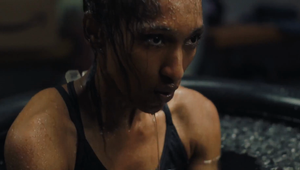
New Talent: Tom Barbor-Might

After watching Tom Barbor-Might’s short documentary for Comfort, ‘Boring’, you’d be forgiven for thinking that it wasn’t all quite real. But it is. Every bit of it. It’s a whimsical story about a town in America’s Pacific Northwest called Boring and beautifully blurs the lines tows the line between fantastical fiction and authentic realism. It’s a joy and recently picked up a branded content VFX award at Ciclope.
LBB’s Addison Capper caught up with Tom to find out more about blurring the lines between fiction and reality and the little town of Boring...
LBB> Your favourite medium to work with is documentary - why?
Tom> In documentaries, stories evolve as apposed to simply being shot. It’s really fun to watch a story unfold in front of your lens and grow and mutate in the edit suite. I like turning all the chaos, unpredictability and non sequitur’s of life into a story, I guess. I always find that real life has a tendency to be surprising, weird and moving in a way that you just can’t script. There is something about the elegance or inelegance of the unscripted line that reaches an audience in a really unique way. It’s not better than great writing of course, it’s just a different kind of brilliant.
LBB> How would you define your style of documentary making? What makes it unique?
Tom> For me documentary doesn’t have to be unimaginative with conventional narratives and typical aesthetics. It doesn’t have a set of rules – documentary doesn’t mind what you do to it as long as the subject is real. I try and find interesting and different ways to approach stories and scripts. I like cinematic narrative structures and rich, highly composed aesthetics. I think it’s also good to break a few rules in the edit suite. Leave in the bits that normally you’d cut out. Capture some of the reality of the way people really are, the backchat, the contradictions and the eccentricities. I like character I guess, moments that reveal personalities, relationships or meanings. I also like to blur a few boundaries; bring things like visual effects and sound design into the form that conventionally don’t belong.
LBB> You pride yourself on bringing cinematic beauty to documentary filmmaking - why so? And how do you make it a reality?
Tom> Again there’s no set of rules that dictates what a documentary is meant to look and feel like. Even down to how it’s lit and how it’s cut. The camera doesn’t have to be predominantly hand-held and interviews shot on a long lens in medium close-ups with the background out of focus. I find this stuff really boring. I like to make the aesthetics serve the story in the way you do in scripted work. So I guess I take the elements you’d normally associate with dramatic production and plonk them into documentary; posh cameras, complicated lighting, grip equipment but most importantly cinematographers and editors who can deliver commercial quality aesthetics in documentary set-ups. It’s a rarefied skill set and I think undervalued.
Then there are a few things I personally like. I’m not such a fan of depth, for instance, and often don’t like moving cameras. I like highly detailed composition and symmetry. I like rich, bold colours and finding subtle mirrors in scenes whether it’s in the architecture or colour pallet. I guess I’m quite a fan of balance. On the whole though, the aesthetics need to serve the creative of course.
LBB> How do you apply that approach when working for brands?
Tom> I’ve found that all this stuff actually blends really well with brands. I guess if people approach me then they’ve already been brave enough to jettison the conventional safety blanket of a fully scripted spot and a screen-tested cast. I think commercial documentary work has this remarkable ability to reach audiences in the most direct and moving of ways. Real people bring a dignity and realism to a campaign, a realism that is not easily ignored. Hopefully if I can bring some strong filmmaking into the mix as well then this can actually be a very powerful thing for a brand. It also doesn’t need to be a risk. With precise direction, meticulous casting and the right kind of production it’s possible to embrace the unexpected, be authentic, but also guarantee a coherent and impactful message, hitting the beats of any script and landing the campaign’s message.
LBB> Let’s talk about Boring, which brilliantly toes the line between fiction and truth. How much did you know about the town prior to being approached for the job?
Tom> I knew absolutely nothing but I’ve always had a penchant for places with weird names. I have this photo of me stood next to a sign for the small Hebridean village of Twatt. Look it up, it’s for real, on Orkney. I was also a fan of Dominic Greyer’s brilliant book, Lesser Spotted Britain. So I kind of had a liking for silly places to begin with. There’s a place called Fucking in Austria.

But I’m glad you mention the line between fiction and fact, as I was keen with this piece to bring a fantastical element to a real place. Boring is 100% real. We filmed everything in the town, not a frame was shot elsewhere. I got to spend over a week in Boring [which is a sentence I never thought I’d say]. All the townsfolk interviewed or featured are real citizens of Boring. It’s too good to be true right? But that’s the weird thing about real life, it’s so often much weirder than anything you could possibly make up.
The magic comes at the end of the film when the bubbles arrive. Obviously with VFX you get into a certain degree of artifice but we really did bring a bubble storm to Boring and everyone featured in that sequence are real residents and their reactions are for real. It was fun to bring a large visual stunt to a documentary and the team at Glassworks did an amazing job helping us create that magical realism.
LBB> Just how boring is Boring?
Tom> It’s a fairly typical small American town. It’s not exactly the most exciting place to visit if I’m completely honest. However, the great irony of Boring is that the people of the town are genuinely, far from boring. In fact they’re pretty brilliant. We kept on meeting wonderful characters full of warmth, wit and a little bit of oddness. We could have shot for a month and not run out of characters. I guess a town called Boring is going to attract a certain type of person.
LBB> What kind of reaction did the residents give you?
Tom> They were all so welcoming and fun. They got the gentle comedy of the piece, the heightened version we were going for – satirical but very warm. If you live in Boring then you are going to be aware of the comic possibilities aren’t you?
LBB> From where did you look for inspiration for the overarching vibe and aesthetic of the film?
Tom> From the off I knew I wanted the film to be as much about place as it is about people. I knew I wanted to play a lot of the film in wides, including the interviews. I wanted to see people in their environments. Let the location help tell the story. So I actually looked a lot to photography for inspiration. Photographers who are really good at capturing urban landscapes like Zack Arias, the ubiquitous Martin Parr of course and Rebecca Bathory. I also really love Bert Teunissen’s domestic landscape project. Photographs have the ability to capture meaning in a single composition. Obviously that’s a remarkable strength of the medium and I tried to capture a bit of that in our approach to showing the town. Our b-roll was highly composed, very 2D and we focused on architecture and unusual details.
In the edit we spoke a lot about films like Best in Show, in terms of the rhythm of comic cutting. It’s all about leaving pauses in.
LBB> What were the most memorable moments of the production?
Tom> Well apart from filling a small town in the Pacific Northwest of America full of bubbles there is one moment that didn’t actually make it into the edit that really stands out in my memory. We were interviewing this local resident, who’d written a local history book called the ‘Book of Boring’ – which I now proudly own. At the beginning of the interview he showed me how he likes to play harmonica to his goat. It was brilliant.
LBB> Which other projects are you particularly proud of and why?
Tom> There are two sides to my work I suppose; the grittier more moving work and the more composed, quirkier stuff. The Urban Riders spot I made for Carphone Warehouse is a good example of the grittier stuff. I’m really proud of the emotion we caught on that project. The quirkier side is well represented by a short film I made for Mazda called Bring Me Sunshine. Stylistically it’s the sister of Boring and I am really proud of the story telling approach we took to that film.
I am really proud of both and hope that a powerful and surprising character testimony is a unifying theme in my work. I love the interview and I think in the right hands it is the most powerful thing. You make such a profound connection with people during an interview. Its one of the rare forms of human communication, where you aren’t just waiting for your turn to speak, you’re really listening. It’s like therapy in that way, it’s a massive privilege to tell someone’s story. If you do it well enough you can get remarkable material from normal people – intimate, surprising and really bloody moving. Its all their in people. Most of the work I do I am lucky enough to work with brave agencies and creatives who are happy to trust this process and accept that we won’t get the exact scripted lines. What we do get, and I say this hand on heart, is always better – it’s always more honest and engaging. The truth always is.
LBB> What is a project that you’d love to be involved in in the future?
Tom> I want to keep exploring that blurred line I was talking about earlier. I like that grey area between fact and fiction. I’ve just finished a narrative short film and it was great to work with an actress and I wonder if I might try and blur things even more in the future. The great thing about advertising is that it’s so brave and people are always fascinated by experimentation and new approaches to the work.













